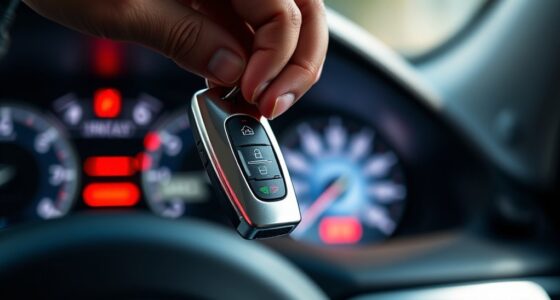Understanding car repair shop jargon can help you communicate more confidently with mechanics and avoid surprises. Terms like OEM parts, T-belt, or diagnostic tools are common, and knowing what they mean makes it easier to ask questions and understand estimates. You’ll also learn about warranty policies, fees, and abbreviations that clarify what’s involved in your repairs. Keep exploring, and you’ll become more comfortable steerIng through the repair process with ease.
Key Takeaways
- Understand common repair abbreviations like OEM and T-belt to better grasp service details.
- Know that diagnostic tools read error codes, helping identify issues quickly and accurately.
- Clarify warranty policies to ensure coverage for parts and labor after repairs.
- Be aware of diagnostic fees and whether they are waived if you proceed with repairs.
- Ask mechanics to explain unfamiliar jargon for clearer communication and better decision-making.

When you visit a car repair shop, you might feel lost among the technical terms and jargon that mechanics use. One of the first things you’ll encounter are diagnostic tools, which are essential for identifying what’s wrong with your vehicle. These tools include scan devices that connect to your car’s computer system, reading error codes that point to specific issues. Understanding that diagnostic tools are standard in modern repairs can help you see why mechanics often run these tests before suggesting any fixes. They save time and ensure accurate diagnoses, preventing unnecessary repairs. As a customer, it’s helpful to ask how these tools are used and what the error codes mean. This way, you stay informed about your car’s condition and avoid surprises when you get the bill.
Another important aspect of car repair jargon involves warranty policies. Mechanics or repair shops usually offer warranties on parts and labor, providing you with peace of mind after a repair. When you hear a mechanic mention warranty policies, they’re talking about the guarantees that protect you if the same problem reoccurs within a specified period or mileage. It’s common for shops to cover parts like alternators or brake pads, but coverage can vary. Always ask what’s included in the warranty, how long it lasts, and if there are any limitations. Knowing your warranty policy helps you understand your rights and can save you money if a problem persists after the initial repair.
Additionally, you may hear terms like “diagnostic fee” or “flat rate.” A diagnostic fee is a charge for running those diagnostic tools and pinpointing issues. Some shops waive this fee if you proceed with the repairs, while others include it in the overall cost. Flat rates refer to a fixed price for a specific repair or service, which can help you budget better. It’s wise to clarify these terms upfront to avoid unexpected expenses. Recognizing common abbreviations like “OEM” for original equipment manufacturer parts or “T-belt” for a timing belt can also help you understand the scope of repairs. These terms are part of the car repair shop jargon that, once familiar, can make communication smoother and more transparent. If you’re unsure about any terminology, don’t hesitate to ask your mechanic for clarification. They’re usually happy to explain, ensuring you’re comfortable with the process and costs involved.
Frequently Asked Questions
What Does “Tune-Up” Really Mean?
A tune-up is a service that improves your car’s engine performance and fuel efficiency. When you get a tune-up, your mechanic checks and replaces parts like spark plugs, filters, and timing belts to guarantee everything runs smoothly. This helps your engine run more efficiently, saves you money on fuel, and prevents future problems. Think of it as a health check for your car to keep it running at its best.
Are There Differences Between “Brake Pads” and “Brake Shoes”?
In brake system terminology, “brake pads” and “brake shoes” are different brake component parts. Brake pads are flat, rectangular components used in disc brakes, pressing against the rotor to stop your vehicle. Brake shoes are curved parts found in drum brakes, pressing outward against the drum. While both help stop your car, their designs and functions differ, so understanding these brake component differences helps you communicate effectively with your mechanic.
How Do I Know if My Car Needs a “Diagnostic Scan”?
Imagine your dashboard lighting up like a Christmas tree—it’s a sign you should get a diagnostic scan. You might notice strange engine noises or poor fuel efficiency, too. During a computer diagnostics, technicians run sensor tests that pinpoint issues quickly. If any warning lights come on or you feel uneven handling, don’t ignore it. A diagnostic scan reveals hidden problems, helping you get back on the road safely and with peace of mind.
What Is the “Check Engine” Light Indicating?
When the “check engine” light comes on, it’s indicating an engine warning that needs attention. This could relate to various issues, including problems with your emission system or other engine components. Don’t ignore it—schedule a diagnostic scan promptly. This helps identify the root cause quickly, ensuring your vehicle runs efficiently and preventing potential damage. Addressing the warning early keeps your car reliable and safe on the road.
Why Do Repair Shops Use so Many Abbreviations?
You might wonder why repair shops use so many abbreviations. In the workshop, mechanics use car terminology and shorthand to communicate quickly and accurately, saving time during diagnostics and repairs. These workshop abbreviations help streamline conversations, especially when referencing specific parts or issues. As a customer, understanding some common abbreviations can help you follow the process and feel more confident about your car’s maintenance or repairs.
Conclusion
Understanding car repair jargon is like learning a new language, making your visits smoother and less stressful. When you know what the mechanic’s talking about, you can ask better questions and feel more confident about the work being done. Think of it as having a map in unfamiliar territory — it helps you navigate with ease. So next time you visit, you’ll feel more prepared and in control, turning a confusing experience into a manageable one.









